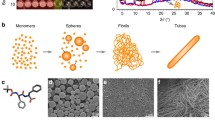Abstract:
The classical isodesmic one-dimensional model for equilibrium polymerization is generalized in order to describe self-assembly in systems forming fibrils. The model was applied to peptide solutions forming -sheet tapes which can further aggregate into stacks of various thickness: double tapes and fibrils (several double tapes stacked together). We found that in some cases the model yields several step-like transitions as the concentration increases: first from monomers to single or double tapes, and then to fibrils. The abruptness of the first transition is controlled by the free energy penalty for transformation of a peptide from random coil to a straight -strand conformation (the latter is characteristic for tapes). If both single and double tapes are allowed, the length of the aggregates after the first transition can be very large with high scission energies. For very low energies of attraction between double tapes, the transition from double tapes to fibrils happens separately (above the first transition), and it is even more abrupt and produces extremely long fibrils. The theoretical findings are used to extract the characteristic molecular parameters for the self-assembly of the de novo peptide DN1 forming polymeric -sheets in water.
Similar content being viewed by others
Author information
Authors and Affiliations
Additional information
Received 28 June 1999
Rights and permissions
About this article
Cite this article
Nyrkova, I., Semenov, A., Aggeli, A. et al. Self-assembly and structure transformations in living polymers forming fibrils. Eur. Phys. J. B 17, 499–513 (2000). https://doi.org/10.1007/s100510070128
Issue Date:
DOI: https://doi.org/10.1007/s100510070128




